Page 582 of 706
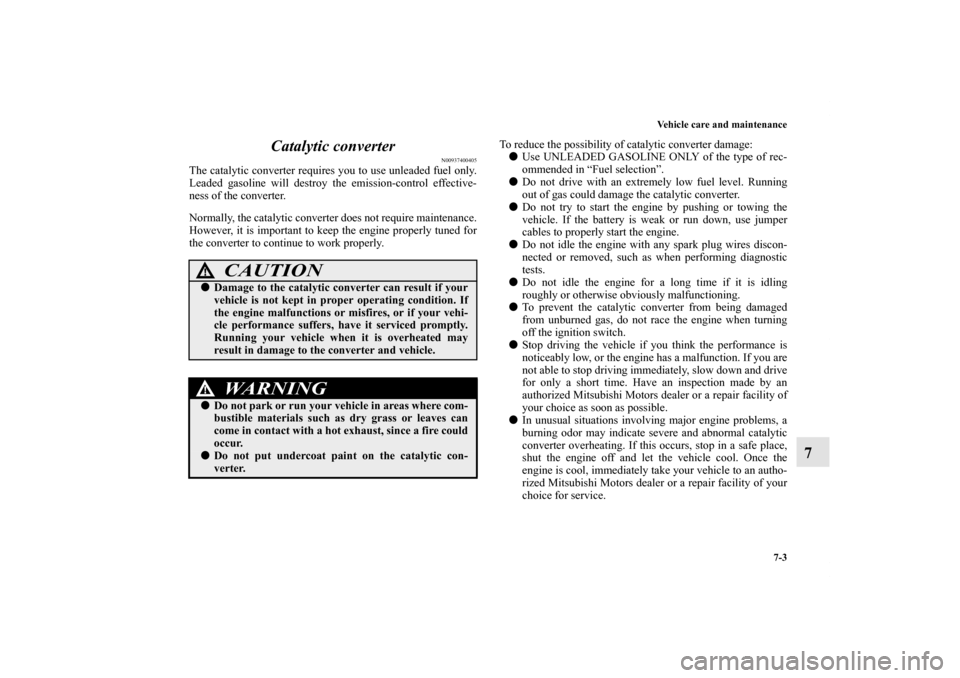
Vehicle care and maintenance
7-3
7 Catalytic converter
N00937400405
The catalytic converter requires you to use unleaded fuel only.
Leaded gasoline will destroy the emission-control effective-
ness of the converter.
Normally, the catalytic converter does not require maintenance.
However, it is important to keep the engine properly tuned for
the converter to continue to work properly. To reduce the possibility of catalytic converter damage:
�Use UNLEADED GASOLINE ONLY of the type of rec-
ommended in “Fuel selection”.
�Do not drive with an extremely low fuel level. Running
out of gas could damage the catalytic converter.
�Do not try to start the engine by pushing or towing the
vehicle. If the battery is weak or run down, use jumper
cables to properly start the engine.
�Do not idle the engine with any spark plug wires discon-
nected or removed, such as when performing diagnostic
tests.
�Do not idle the engine for a long time if it is idling
roughly or otherwise obviously malfunctioning.
�To prevent the catalytic converter from being damaged
from unburned gas, do not race the engine when turning
off the ignition switch.
�Stop driving the vehicle if you think the performance is
noticeably low, or the engine has a malfunction. If you are
not able to stop driving immediately, slow down and drive
for only a short time. Have an inspection made by an
authorized Mitsubishi Motors dealer or a repair facility of
your choice as soon as possible.
�In unusual situations involving major engine problems, a
burning odor may indicate severe and abnormal catalytic
converter overheating. If this occurs, stop in a safe place,
shut the engine off and let the vehicle cool. Once the
engine is cool, immediately take your vehicle to an autho-
rized Mitsubishi Motors dealer or a repair facility of your
choice for service.
CAUTION
!�Damage to the catalytic converter can result if your
vehicle is not kept in proper operating condition. If
the engine malfunctions or misfires, or if your vehi-
cle performance suffers, have it serviced promptly.
Running your vehicle when it is overheated may
result in damage to the converter and vehicle.
WA R N I N G
!�Do not park or run your vehicle in areas where com-
bustible materials such as dry grass or leaves can
come in contact with a hot exhaust, since a fire could
occur.�Do not put undercoat paint on the catalytic con-
verter.
BK0125300US.book 3 ページ 2010年5月18日 火曜日 午後1時53分
Page 586 of 706
Vehicle care and maintenance
7-7
7 View of the engine compartment
N00937600654
Except for vehicles with turbocharger
1- Power steering fluid reservoir
2- Air cleaner filter
3- Brake fluid/Clutch fluid reservoir (if so equipped)
4- Engine coolant reservoir
5- Windshield washer fluid reservoir
6- Engine oil level dipstick
7- Radiator cap
8- Engine oil filler cap
9- Battery Vehicles with turbocharger
BK0125300US.book 7 ページ 2010年5月18日 火曜日 午後1時53分
Page 602 of 706
Vehicle care and maintenance
7-23
7 Battery
N00939100826
The condition of the battery is very important for quick starting
and to keep the vehicle’s electrical system working properly.
Check the battery regularly. Removing and installing the battery upper cover
(vehicles equipped with turbocharger)
N00901300025
To r e m o v e1. Remove the two clips (A), and then remove the air duct
(B).
WA R N I N G
!�An SRS airbag sensor is located in the front of the
engine compartment near the battery.
When checking or replacing the battery, or when
working around this area, do not strike or damage
this sensor.
WA R N I N G
!�Turn the ignition switch to the “LOCK” position on
vehicle. Make sure that your clothes cannot be
caught by the fan or drive belt. Personal injury
could result.
BK0125300US.book 23 ページ 2010年5月18日 火曜日 午後1時53分
Page 603 of 706
7-24 Vehicle care and maintenance
7
2. Turn the plastic nuts (C) counterclockwise, and then
remove the battery upper cover (D).NOTE�Be careful not to lose the removed plastic nuts.
To i n s t a l l1. Install the battery upper cover (A) onto the battery, and
then push the plastic nuts (B) in the direction shown by
the arrows to secure the cover.NOTE�Be sure to install the plastic nuts in the correct direction.
�Make sure that the battery upper cover is installed
securely.
2. To install the air duct, perform the removal steps in
reverse.
BK0125300US.book 24 ページ 2010年5月18日 火曜日 午後1時53分
Page 604 of 706
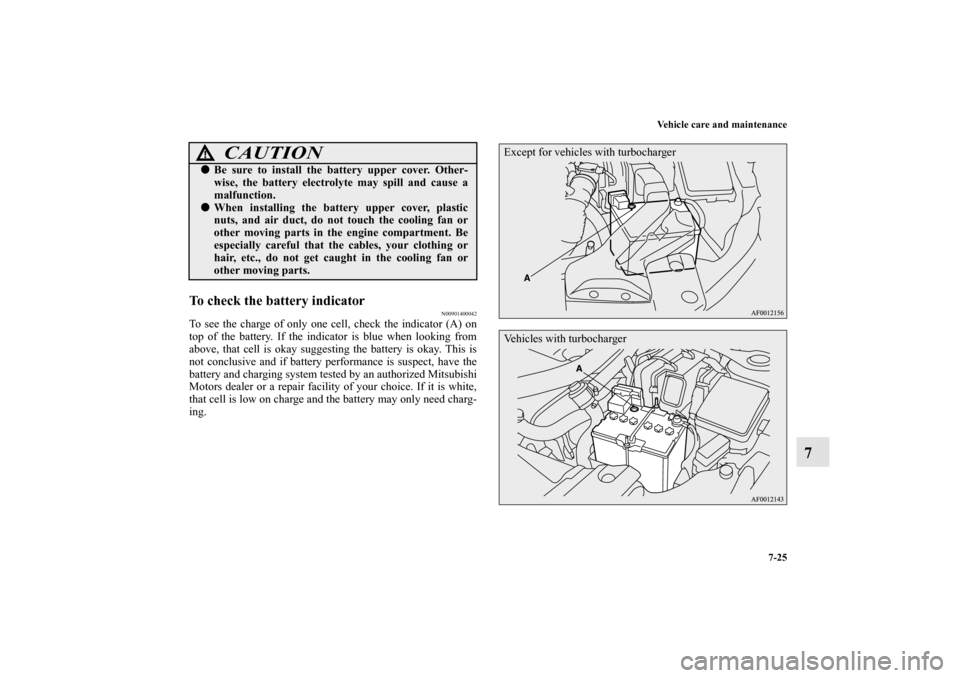
Vehicle care and maintenance
7-25
7
To check the battery indicator
N00901400042
To see the charge of only one cell, check the indicator (A) on
top of the battery. If the indicator is blue when looking from
above, that cell is okay suggesting the battery is okay. This is
not conclusive and if battery performance is suspect, have the
battery and charging system tested by an authorized Mitsubishi
Motors dealer or a repair facility of your choice. If it is white,
that cell is low on charge and the battery may only need charg-
ing.
CAUTION
!�Be sure to install the battery upper cover. Other-
wise, the battery electrolyte may spill and cause a
malfunction.�When installing the battery upper cover, plastic
nuts, and air duct, do not touch the cooling fan or
other moving parts in the engine compartment. Be
especially careful that the cables, your clothing or
hair, etc., do not get caught in the cooling fan or
other moving parts.
Except for vehicles with turbochargerVehicles with turbocharger
BK0125300US.book 25 ページ 2010年5月18日 火曜日 午後1時53分
Page 605 of 706
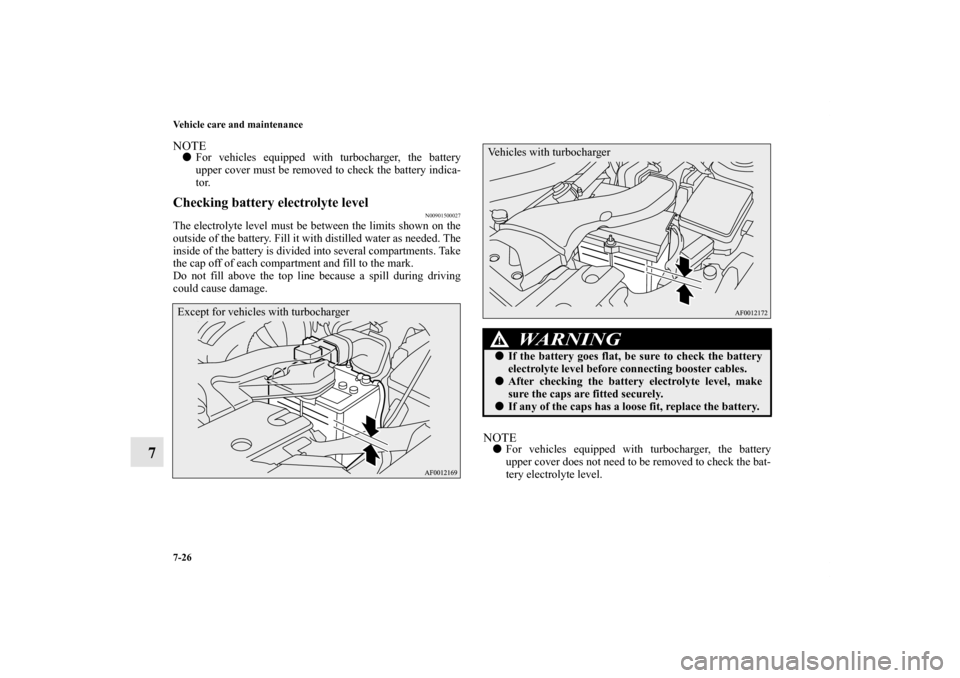
7-26 Vehicle care and maintenance
7
NOTE�For vehicles equipped with turbocharger, the battery
upper cover must be removed to check the battery indica-
tor.Checking battery electrolyte level
N00901500027
The electrolyte level must be between the limits shown on the
outside of the battery. Fill it with distilled water as needed. The
inside of the battery is divided into several compartments. Take
the cap off of each compartment and fill to the mark.
Do not fill above the top line because a spill during driving
could cause damage.
NOTE�For vehicles equipped with turbocharger, the battery
upper cover does not need to be removed to check the bat-
tery electrolyte level.
Except for vehicles with turbocharger
WA R N I N G
!�If the battery goes flat, be sure to check the battery
electrolyte level before connecting booster cables.�After checking the battery electrolyte level, make
sure the caps are fitted securely.�If any of the caps has a loose fit, replace the battery.Vehicles with turbocharger
BK0125300US.book 26 ページ 2010年5月18日 火曜日 午後1時53分
Page 606 of 706
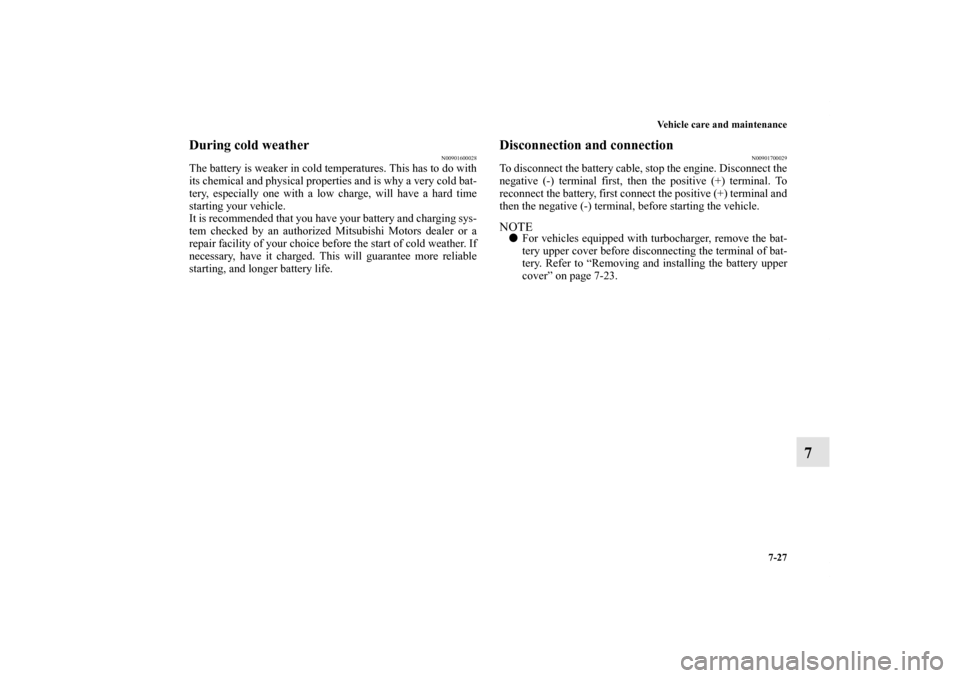
Vehicle care and maintenance
7-27
7
During cold weather
N00901600028
The battery is weaker in cold temperatures. This has to do with
its chemical and physical properties and is why a very cold bat-
tery, especially one with a low charge, will have a hard time
starting your vehicle.
It is recommended that you have your battery and charging sys-
tem checked by an authorized Mitsubishi Motors dealer or a
repair facility of your choice before the start of cold weather. If
necessary, have it charged. This will guarantee more reliable
starting, and longer battery life.
Disconnection and connection
N00901700029
To disconnect the battery cable, stop the engine. Disconnect the
negative (-) terminal first, then the positive (+) terminal. To
reconnect the battery, first connect the positive (+) terminal and
then the negative (-) terminal, before starting the vehicle. NOTE�For vehicles equipped with turbocharger, remove the bat-
tery upper cover before disconnecting the terminal of bat-
tery. Refer to “Removing and installing the battery upper
cover” on page 7-23.
BK0125300US.book 27 ページ 2010年5月18日 火曜日 午後1時53分
Page 607 of 706
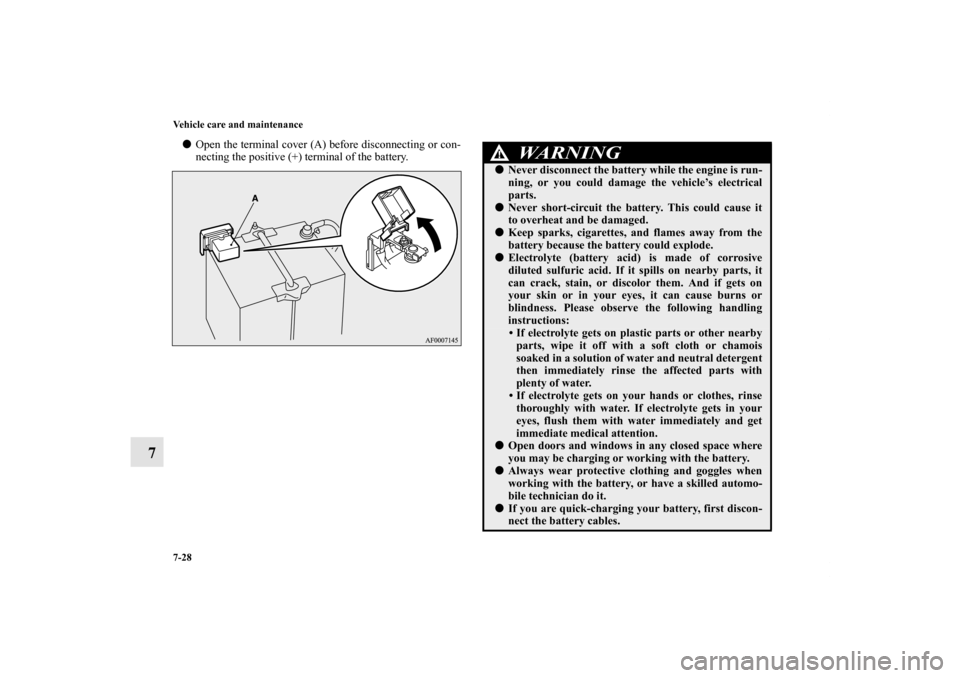
7-28 Vehicle care and maintenance
7
�Open the terminal cover (A) before disconnecting or con-
necting the positive (+) terminal of the battery.
WA R N I N G
!�Never disconnect the battery while the engine is run-
ning, or you could damage the vehicle’s electrical
parts. �Never short-circuit the battery. This could cause it
to overheat and be damaged. �Keep sparks, cigarettes, and flames away from the
battery because the battery could explode. �Electrolyte (battery acid) is made of corrosive
diluted sulfuric acid. If it spills on nearby parts, it
can crack, stain, or discolor them. And if gets on
your skin or in your eyes, it can cause burns or
blindness. Please observe the following handling
instructions:
• If electrolyte gets on plastic parts or other nearby
parts, wipe it off with a soft cloth or chamois
soaked in a solution of water and neutral detergent
then immediately rinse the affected parts with
plenty of water.
• If electrolyte gets on your hands or clothes, rinse
thoroughly with water. If electrolyte gets in your
eyes, flush them with water immediately and get
immediate medical attention.
�Open doors and windows in any closed space where
you may be charging or working with the battery. �Always wear protective clothing and goggles when
working with the battery, or have a skilled automo-
bile technician do it. �If you are quick-charging your battery, first discon-
nect the battery cables.
BK0125300US.book 28 ページ 2010年5月18日 火曜日 午後1時53分